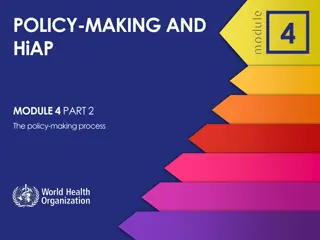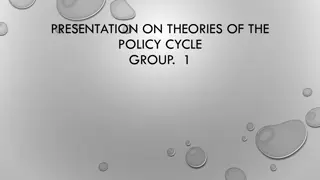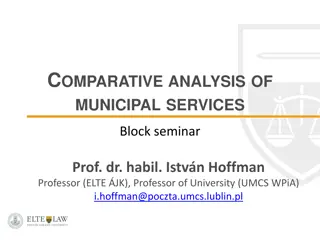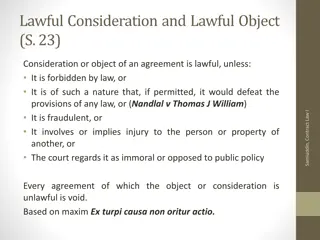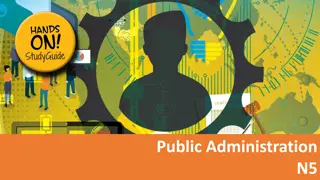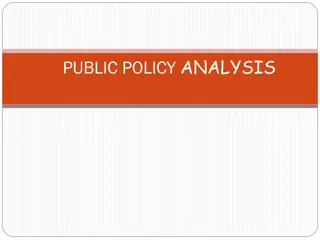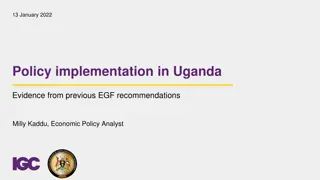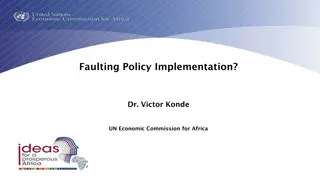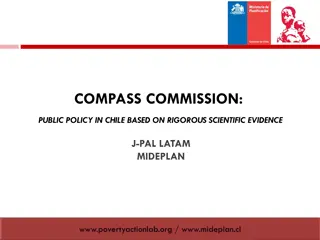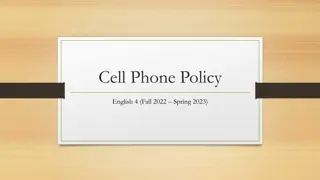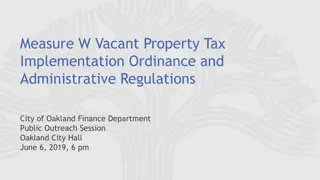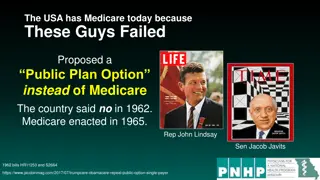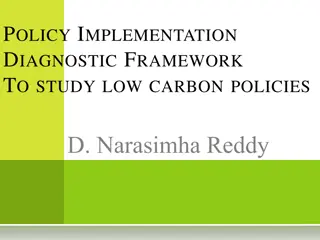Evolution of Public Policy Implementation Studies
Implementation studies focus on policy change and translating policies into action. These studies emerged in the 1970s in the United States, with different generations highlighting the challenges and approaches to policy implementation. The evolution of top-down, bottom-up, and hybrid theories in implementation research reflects the ongoing efforts to improve the effectiveness of public policy execution.
Download Presentation

Please find below an Image/Link to download the presentation.
The content on the website is provided AS IS for your information and personal use only. It may not be sold, licensed, or shared on other websites without obtaining consent from the author.If you encounter any issues during the download, it is possible that the publisher has removed the file from their server.
You are allowed to download the files provided on this website for personal or commercial use, subject to the condition that they are used lawfully. All files are the property of their respective owners.
The content on the website is provided AS IS for your information and personal use only. It may not be sold, licensed, or shared on other websites without obtaining consent from the author.
E N D
Presentation Transcript
IMPLEMENTING PUBLIC POLICY IMPLEMENTING PUBLIC POLICY S S\ \N N 1 2 3 4 GROUP MEMBERS GROUP MEMBERS IREFIN OLUWATOSIN ELUMELU GRACE BOADE OLAMILEKAN TAOFIQ ELUMEZE ANTHONY MATRIC MATRIC NO 16\SMS10\010 16/SMS10/006 12\SMS10\006 16/SMS09/047 NO
INTRODUCTION Implementation studies can be characterized as studies of policy change (Jenkins 1978, 203). Goggin and his colleagues(1990) implementation research. Implementation studies emerged in the 1970s within the United States, as a reaction to growing concerns over the effectiveness of wide-ranging reform programs. The process of translating policy into action (Barrett 2004, 251) attracted more attention, as policies seemed to lag behind policy expectations. The first generation of implementation studies, which dominated much of the 1970s, was characterized by a pessimistic undertone. This pessimism was fuelled by a number of case studies that represented shining examples of implementation failure. The most noteworthy achievement of the first generation of implementation researchers was to raise awareness of the issue in the wider scholarly community and in the general public. identified three generations of
INTRODUCTION CONT. The second generation began to put forward a whole range of theoretical frameworks and hypotheses. This period was marked by debates between what was later describe as the top-down and bottom-up approaches to implementation research. The top-down school conceived of implementation as the hierarchical execution of centrally-defined policy intentions. The bottom-up camp, instead emphasized that implementation consisted of the everyday problem-solving strategies of street-level bureaucrats (Lipsky 1980). The third generation of implementation research tried to bridge the gap between top-down and bottom-up approaches by incorporating the insights of both camps into their theoretical models. At the same time, the self-proclaimed goal of third-generation research was to be more scientific than the previous two in its approach to the study of implementation .
TOP-DOWN, BOTTOM-UP, AND HYBRID THEORIES OF IMPLEMENTATION The three generations of implementation research presented earlier can be subdivided into three distinct theoretical approaches to the study of implementation: 1. Top-down models put their main emphasis on the ability of decision makers to produce unequivocal policy objectives and on controlling the implementation stage. 2. Bottom-up critiques view local bureaucrats as the main actors in policy delivery and conceive of implementation as negotiation processes within networks of implementers. 3. Hybrid theories try to overcome the divide between the other two approaches by incorporating elements of top- down, bottom-up and other theoretical models.
TOP TOP- -DOWN THEORIES DOWN THEORIES Top-down implementation starts with a decision made by central government. Parsons (1995, 463) points out that these studies were based on a blackbox model of the policy process inspired by systems analysis. Due to their emphasis on decisions of central policy makers, deLeon (2001, 2) describes top-down approaches as a governing elite phenomenon . Pressman and Wildavsky s original work followed a rational model approach. They saw implementation as an interaction between the setting of goals and actions geared to achieve them . They argued that effective implementation becomes increasingly difficult, if a program has to pass through a multitude of clearance points. theories started from the assumption that policy
CONT. CONT. American scholars Van Meter and Van Horn (1975) offered a more elaborate theoretical model. They were concerned with the study of whether implementation outcomes corresponded to the objectives set out in initial policy decisions. The authors also highlighted two variables that slightly departed from the top-down mainstream : They argued that the extent of policy change had a crucial impact on the likelihood of effective implementation and that the degree of consensus on goals was important. Hence, significant policy change was only possible if goal consensus among actors was high. The model of Van Meter and Van Horn was less concerned with advising policy makers on successful implementation but with providing a sound basis for scholarly analysis.
CONT CONT Bardach s book The Implementation Game, published in 1977, provided a classical metaphor for the implementation process. He acknowledged the political character of the implementation process and therefore promoted the idea of using game theoretic tools for explaining implementation. Bardach thus provided ideas that also influenced bottom-up scholars. However, his preoccupation with advising policy makers on how to improve implementation makes him a clear member of the top-down camp. His core recommendation was to give attention to the scenario writing process, which meant that successful implementation was possible if policy makers succeeded in structuring the implementation games thoughtfully. Sabatier and Mazmanian (1979, 1980, also Mazmanian and Sabatier 1983) are among the core authors of the top-down approach. Like Van Meter and Van Horn (1975), Sabatier and Mazmanian started their analysis with a policy decision that was made by governmental representatives.
CONT. Sabatier and Mazmanian (1979, 1980) are among the core authors of the top-down approach. Sabatier and Mazmanian started their analysis with a policy decision that was made by governmental representatives. Therefore, they assumed a clear separation of policy formation from policy implementation. Their model lists six criteria for effective implementation: (1) policy objectives are clear and consistent, (2) the program is based on a valid causal theory (3) the implementation process is structured adequately (4) implementing officials are committed to the program s goals (5) interest groups and (executive and legislative) sovereigns are supportive (6) there are no detrimental changes in the socioeconomic framework conditions. Sabatier and Mazmanian (1979), they argued that policy makers could ensure effective implementation through adequate program design and a clever structuration of the implementation process.
BOTTOM UP THEORY In the late 1970s and early 1980s, bottom-up theories emerged as a response to the topdown school of thought. Theorists suggested studying what was actually happening on the recipient level and analyzing the real causes that influence action on the ground The classical bottom-up researchers are: the American researchers Lipsky (1971, 1980) and Elmore (1980) as well as the Swedish scholar Hjern (1982), also in collaboration with other authors such as Porter and Hull. The main concern of Elmore (1980) was the question of how to study implementation. Instead of assuming that policy makers effectively control implementation, his concept of backward mapping suggested that analysis should start with a specific policy problem and then examine the actions of local agencies to solve this problem.
CONT. The Swedish scholar Hjern, in close cooperation with colleagues like Porter and Hull, focuses on implementation analysis starting with the identification of networks of actors from all relevant agencies collaborating in implementation and then examine the way they try to solve their problems. According to Sabatier (1986a), this approach offers a useful tool to describe the implementation structures
COMPARATIVE DISCUSS They both differ in research strategies, goals of analysis, models of the policy process implementation process and models of democracy. 1. Top-downers typically start from a policy decision reached at the top of the political system and work their way down to the implementers. Bottom-uppers, in contrast, start out with the identification of actors involved in concrete policy delivery at the bottom of the politico-administrative system. 2. The goal of analysis of top-down scholars is to reach a general theory of implementation. The aim of bottom-up studies, in contrast, is rather to give an accurate empirical description and explanation of the interactions and problem- solving strategies of actors involved in policy delivery.
CONT. 3. Top-down analyses does not focus on the whole policy process, but merely on what happens after a bill becomes a law . In contrast, bottom-up approaches argue that policy implementation cannot be separated from policy formulation. Hence, bottom-up scholars do not just pay attention to one particular stage of the policy cycle. 4. Top-down understands implementation as the carrying out of a basic policy decision. In this view, implementation is an administrative process. Bottom- up suggests that policies are by the largely autonomous political decisions of the actors directly involved in policy delivery.
CONT. 5. Topdown approaches are rooted in representative democracy. They stress that local bureaucrats, affected target groups and private actors have legitimate concerns to be taken into account as well.
HYBRID THEORY As a result of growing debate between top-downers and bottom-uppers researchers tried to synthesize both approaches combining elements of both sides. Elmore (1985) argued that a program success is based upon both elements, as they are intertwined (Sabatier 1986) and policy makers should therefore start with the consideration of policy instruments and available resources for policy change. Sabatier (1986) advocacy coalition framework This conception has some resemblance with the bottom-up approach as the analysis starts from a policy problem and proceeds in reconstructing the strategies of relevant actors to solve this problem.
CONT. Scharpf (1978)Introduced the concept of policy networks to implementation research , he suggested giving more weight to processes of coordination and collaboration among separate but mutually dependent actors.
CONT. Winter (1990) contributed to overcoming the separation of policy formation and implementation. Goggin, Bowman, Lester, and O Toole (1990), accept the perspective of a centrally defined policy decision to be implemented by lower-level actors. Some scholars are of the view that they fail to address the question of the type of policy to be implemented, Building on the seminal article by Lowi (1972), Ripley and Franklin (1982) distinguish between distributive, regulatory, and redistributive policies, arguing that
NEW DEVELOPMENTS IN IMPLEMENTATION ANALYSIS 1.Implementation in an international context: news from European integration studies 2.The interpretative approach to policy implementation
IMPLEMENTATION IN AN INTERNATIONAL CONTEXT: NEWS FROM EUROPEAN INTEGRATION STUDIES The first wave of studies addressing issues in the context of European integration started out as a failure to the extent that theoretical conclusions were drawn at all, which primarily mirrored the insights of the top down school in implementation theory. The second wave of implementation was embraced and evolved in the 1990s .it focused on European environmental policy, one of which the implementation gaps had become particularly visible. Problems of policy execution were put down to technical parameter such as insufficient administrative resources; inter organized co ordination problems or cumbersome legislative at the domestic level
IMPLEMENTATION IN AN INTERNATIONAL CONTEXT: NEWS FROM EUROPEAN INTEGRATION STUDIES The degree of misfits, that is the extent to which a particular supranational policy required members states to depart from their traditional ways of doing things in terms of policy legacies and organizational arrangements, thus moved to the forefront in explaining implementation outcomes.
THE INTERPRETATIVE APPROACH TO POLICY IMPLEMENTATION . It looks at the strict distinction between facts and values underlying the positivity of philosophy of science as untenable and it challenges the possibility of neutral and unbiased observations. In Yanows words (200,ix) it means that implementation analysis shifts the discussion from values as a set of meanings and from a view of human behaviour as ideally instrumentally and technically rational to human action as expressive . Interpretative approach does not take the factual essence of problems as its main point but shows that multiple and sometimes ambigious and conflicting meanings
LESSONS LEARNT WITH THE AID OF IMPLEMENTATION RESEARCH. 1.It has helped put to understanding that Implementation processes should not be viewed in isolation. 2. To learn more about the contrasting logics of implementation in different country settings, more research with an explicit focus on cross country comparison is needed. 3. Implementation and policy formulation are highly interdependent processes. 4.Implementation is more than the a theoretical question. 5.Implementation is a continuum located between central guidance and local autonomy.
CONTRIBUTION OF IMPLEMENTATION STUDIES. Displayed important impulse for the development of alternatives to the model of representative democracy. Paved way for a more realistic conception of the institutional features and the role of modern public administration in politics. it gave an important impulse for the development of alternatives to the model of representatives.
PERSISTENT WEAKNESSES THAT AFFECTED THE VISIBILITY OF IMPLEMENTATION. It was characterized by a share positivist ontology and epistemology that largely ignores the role of discourses. The theoretical models presented by implementation scholars. Lack of cumulation.
CONCULSION From this chapter we can learn that implementation research has given a lot of insights into the field of implementation and in the wider world of social sciences. However, implementation analysis have been hindered by three weaknesses; a lack of cumulation, no definite resolution most times and its ignorance in the roles of symbols and cultural patterns. These weaknesses should not suggest its abolition, rather a separate analysis of implementation is useful since the actors involved in policy formation and implementation.



